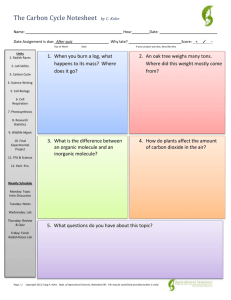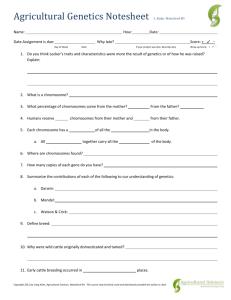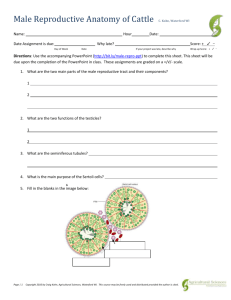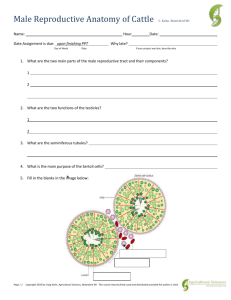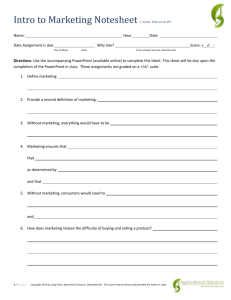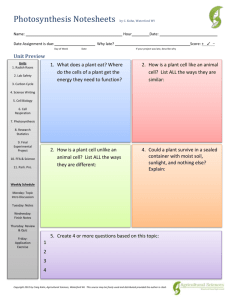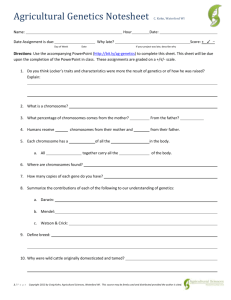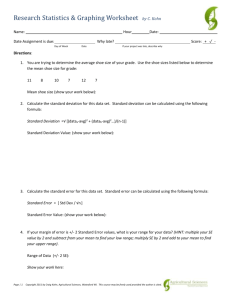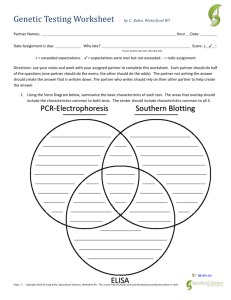Notesheet
advertisement
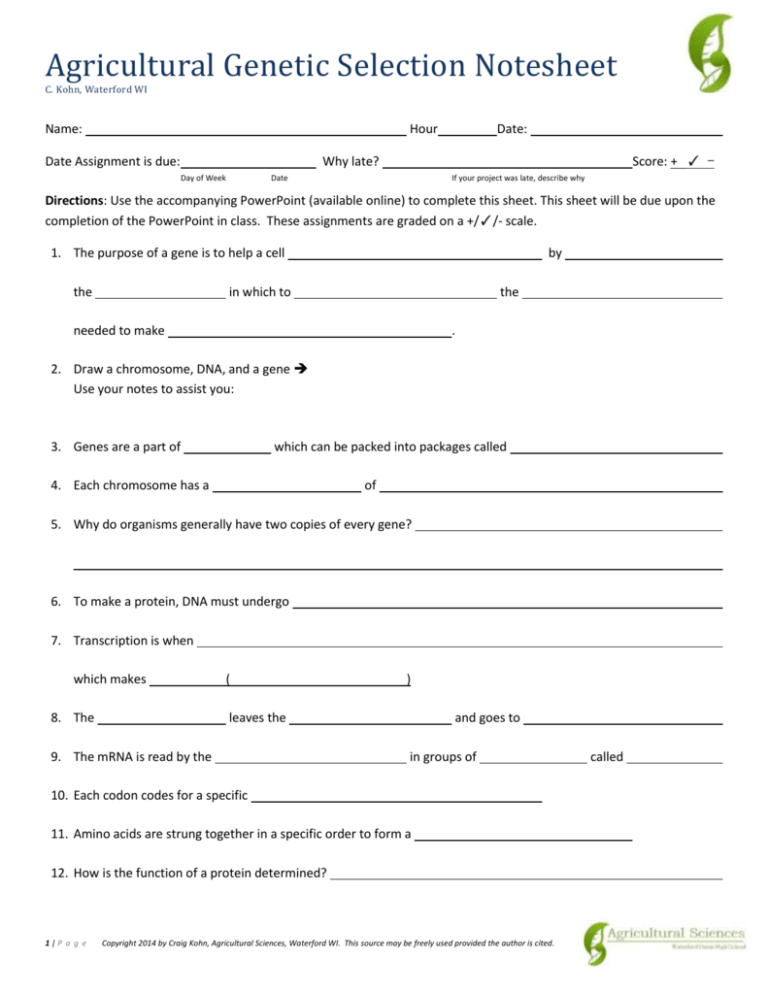
Agricultural Genetic Selection Notesheet C. Kohn, Waterford WI Name: Hour Date Assignment is due: Date: Score: + ✓ - Why late? Day of Week Date If your project was late, describe why Directions: Use the accompanying PowerPoint (available online) to complete this sheet. This sheet will be due upon the completion of the PowerPoint in class. These assignments are graded on a +/✓/- scale. 1. The purpose of a gene is to help a cell the by in which to the needed to make . 2. Draw a chromosome, DNA, and a gene Use your notes to assist you: 3. Genes are a part of which can be packed into packages called 4. Each chromosome has a of 5. Why do organisms generally have two copies of every gene? 6. To make a protein, DNA must undergo 7. Transcription is when which makes 8. The ( ) leaves the 9. The mRNA is read by the and goes to in groups of 10. Each codon codes for a specific 11. Amino acids are strung together in a specific order to form a 12. How is the function of a protein determined? 1|P a g e Copyright 2014 by Craig Kohn, Agricultural Sciences, Waterford WI. This source may be freely used provided the author is cited. called 13. How is the shape of the protein determined? 14. What is primarily responsible for the traits seen in an organism? 15. The more the of a plant or animal, the more the plant or animal is to an 16. For over , humans have selected the plants and animals that have the , increasing the likelihood that these traits would be 17. This has resulted in major became more to species over time as and less valuable genes become 18. What species did cattle today descend from 19. How was the auroch different from today’s cattle? List three differences: 20. Summarize how the auroch was domesticated into the modern cow: 21. Domestication means to 22. This is usually done through 2|P a g e , which is the process in which Copyright 2014 by Craig Kohn, Agricultural Sciences, Waterford WI. This source may be freely used provided the author is cited. 23. How is this different from natural selection? 24. How does domestication work? 25. Domestication results in species that are but also are 26. The improvements in the usually results in the 27. How is corn an example of this? 28. Early domestication usually occurred in 29. Prior to 1900, most agricultural breeding was the result of with 30. Over time, widely different kinds of cattle in an area would become as 31. As a result of specific breeds of cattle began to that were to the 3|P a g e Copyright 2014 by Craig Kohn, Agricultural Sciences, Waterford WI. This source may be freely used provided the author is cited. 32. What is a breed? 33. Summarize the main traits of the Holstein: 34. Summarize the main traits of the Jersey: 35. Summarize the main traits of the Brown Swiss: 36. Summarize the main traits of the Ayrshire and Guernsey: 37. Summarize the main traits of the Milking Shorthorn: 38. As the benefits of selective breeding became better understood, began to form. 39. What was their purpose? 40. They kept track of the performance of by their 41. How did this data help farmers? 42. Summarize the four ways in which changes occur to the genetic make-up of a species: Mutations: 4|P a g e Copyright 2014 by Craig Kohn, Agricultural Sciences, Waterford WI. This source may be freely used provided the author is cited. Random Drift: Selection: Crossbreeding: 43. What is hybrid vigor? 44. If the offspring of mixed parents have greater productivity, why not always cross different breeds? 45. An agriculturalist cannot control if but they can 46. This puts added pressure on an agriculturalist to 47. How do continuous traits affect genetic selection? 48. What is a continuous trait? 49. What is a discontinuous trait? 50. Why can’t we predict milk production in a Holstein in the same way we can predict body color? 51. How do histograms help predict the outcome for continuous traits? 5|P a g e Copyright 2014 by Craig Kohn, Agricultural Sciences, Waterford WI. This source may be freely used provided the author is cited. 52. What is a bell curve? 53. What are outliers? 54. What is heritability? 55. What is the highest heritability value? What is the lowest? 56. Traits with a heritability of 0.1 or less have 57. What is an example of this? , meaning Most of this trait is determined by 58. Traits with a heritability of 0.1-0.3 have 59. What is an example of this? , and are meaning it is mostly affected by 60. Traits with a heritability of 0.3 have 61. What is an example of this? , and are meaning that we cannot improve milk quality 62. If we want to improve a trait, we need to determine whether we can best improve it through 6|P a g e Copyright 2014 by Craig Kohn, Agricultural Sciences, Waterford WI. This source may be freely used provided the author is cited. 63. If a trait has low heritability, does this mean we can ignore breeding for it every time? 64. Summarize the four factors that affect how quickly a species can be improved: Accuracy: Intensity: Genetic Variation: Genetic Interval: 65. What is correlation? 66. Correlation is related to what topic in Mendelian genetics? 67. What is negative correlation? 68. What is an example of negative correlation? 69. Do the Jersey and Holstein breeds reflect this idea? Explain: HINT: what is the Holstein known for? What is the Jersey known for? 70. What is positive correlation? 71. What is an example of positive correlation? 7|P a g e Copyright 2014 by Craig Kohn, Agricultural Sciences, Waterford WI. This source may be freely used provided the author is cited. Explain: 72. What is Galton’s Law? 73. Galton’s Law means that while we are more likely to have from , the the parents, the less likely the offspring 74. Will the best cow in the world have a daughter who also becomes the best cow in the world? Explain why: 75. What is artificial insemination? 76. How is this different from natural insemination? 77. AI enables one bull to reducing the need for 78. Instead of only having access to your herd’s genetics by 79. What are three ways in which dairy cattle genetics have changed dramatically since 1900? 80. What is a sire summary? 8|P a g e Copyright 2014 by Craig Kohn, Agricultural Sciences, Waterford WI. This source may be freely used provided the author is cited. , you could improve 81. This information can provide a farmer or breeder with the they need to select 82. Sire summaries focus primarily on what? What is this? 83. This information can then be used to determine 84. A PTA Score can be expressed as a 85. An animal that scores +3 for a trait would be the in regards to that trait. 86. An animal that scores -3 for a trait would be the in regards to that trait. 87. An animal that scores 0 for a trait would be in regards to that trait. 88. A bull that scores a +3 on a highly heritable trait could the average production of a and that bull’s genetics would be worth 89. How did Dr. Stephen Babcock contribute to creating modern dairy cows? 90. Babcock’s test not only helped prevent but provided a basis by which to 91. It was also the first 9|P a g e Copyright 2014 by Craig Kohn, Agricultural Sciences, Waterford WI. This source may be freely used provided the author is cited. Unit Wrap-up C. Kohn, Agricultural Sciences - Waterford WI This page is designed to help raise your grade while enabling you to develop skills you will need for after high school. You will need to complete every question and blank in order to receive full credit for your notes. Note: if you cannot come up with a strategy to remember a difficult concept on your own, see your instructor for help. 1. What is a topic or concept from this unit that you found to be more challenging? Write or describe below: In the space below, create a mnemonic, rhyme, analogy, or other strategy to help you remember this particular concept: 2. What is a 2nd topic or concept from this unit that you found to be more challenging? Write or describe below: In the space below, create a mnemonic, rhyme, analogy, or other strategy to help you remember this particular concept: 3. What is a 3rd topic or concept from this unit that you found to be more challenging? Write or describe below: In the space below, create a mnemonic, rhyme, analogy, or other strategy to help you remember this particular concept: 4. Circle the most appropriate response. You will only be graded on whether or not you completed this section, so be entirely honest with yourself when completing this section. Circle one: I used my notes outside of class to prepare for the quiz. Definitely – Yes – Sort of - No Circle one: I took extra notes in the margins for very difficult concepts. Definitely – Yes – Sort of - No Circle one: I created a personal strategy for at least three difficult items. Definitely – Yes – Sort of - No Circle one: I was very involved and actively studying during the quiz review. Definitely – Yes – Sort of - No Circle one: I think I will be satisfied with the quiz grade I received this week. Definitely – Yes – Sort of - No Circle one: I might need to meet with the instructor outside of class. 10 | P a g e Definitely – Yes – Sort of - No Copyright 2014 by Craig Kohn, Agricultural Sciences, Waterford WI. This source may be freely used provided the author is cited.
